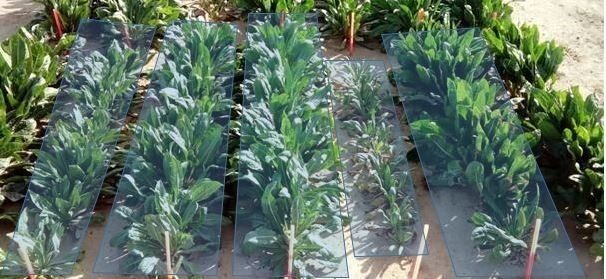Press release Making F1 hybrids more efficient in chicory: a stepping stone to higher inulin production

An improved technique for the production of parent lines for so-called F1 hybrids of industrial chicory can contribute to chicory roots with an estimated 20% more inulin. This is the most striking result of the ILVO-UGent doctoral research conducted by Jeroen Van der Veken. The greatest success was in the preparatory work: making haploid plants (with halved DNA quantity; each chromosome is present only once) that serve as the starting material for the parent lines.
Rich history
Demand for inulin as raw material
Food companies use inulin, a chain of fructose molecules, as a prebiotic dietary fiber in dairy and bakery products, among others. Inulin stimulates the growth of beneficial intestinal bacteria, and it can be used as a fat substitute or in the cosmetic sector. Inulin from chicory roots is therefore a desirable product, and Belgium is the largest chicory-growing and manufacturing country in the world. Figures from 2018 indicate that 8405 ha of industrial chicory was cultivated and the area is growing. The selling price amounts to approximately 3600 €/ha and the farmers are currently aiming at an average yield of about 8 tons of inulin/ha. More inulin in the harvested roots would be beneficial for farmers and the processing industry. Therefore, breeding pathways are followed closely. The development of F1 hybrids, the productive offspring of crossed inbred lines, in chicory can provide an estimated 20% higher production of inulin in the roots. But that requires in-depth research into breeding techniques, to which Jeroen Van der Veken contributed substantially.Suitable parents and controlled pollination
There are two main prerequisites for making F1 hybrids in chicory. The first condition is the rapid production of homozygous parental plants, with two identical copies of all genes and chromosomes. The second is a reliable system for pollination control, such as cytoplasmic male sterility (CMS). In addition, an older plant has a genetic defect in the cytoplasm DNA (the DNA in the plasma around the nucleus), which makes the development of normal pollen impossible. This last factor ensures certainty about the fatherhood of the resulting plants, because the flowers cannot pollinate themselves. But how can we induce homozygote parent plants? What techniques are most appropriate for this purpose and can we influence their efficiency? And is the cytoplasmic male sterility in chicory stable enough? Thanks to several laboratory experiments, Jeroen Van der Veken was able to produce homozygous lines by inducing and doubling haploid plants, and he was able to demonstrate that cytoplasmic male sterility can be nullified by high ambient temperatures.
Doubling of 'half' parents
Homozygous lines can be obtained by self-pollination, but this is a time-consuming inbreeding process. This can be circumvented by the use of haploids – plants with only 1 set of chromosomes instead of 2. In order to halve the genetic material, Jeroen Van der Veken performed type crossings between chicory and related species of the same family, followed by in vitro culture of the immature embryo and further regeneration (letting it grow into plants). This is where medium composition and the genotypes used determine the success. Only pollination with Cicerbita alpina yielded haploid plants, presumably because the chromosomes of this related species are eliminated after fertilization. A doubling of these haploids eventually yielded homozygote parents in a fairly fast way.
Unstable infertility?
The stability of cytoplasmic male sterility was investigated by exposing CMS plants to controlled high temperatures and studying the effect on their fertility. The stability of the CMS after temperature shock in various lines was mapped. Several lines produced fertile pollen grains 12 to 17 days after the heat shock, indicating that this type of CMS is not always stable and is not completely reliable as a means of controlling hybridizations. This is important because if CMS no longer works, for example after a heatwave in the field, the plant can pollinate itself. The seed that is then harvested is partly the result of undesirable self-pollination, so no F1 hybrid plants will grow out in that case.
Reliable CMS is therefore essential for good seed quality, and Jeroen Van der Veken therefore mapped out the expression of genes in various flower bud stages of "normal" and CMS plants. Several genes linked to flower bud maturation, identified through these and previous studies, were found to have a different expression pattern in CMS plants. Also through microscopy, differences were observed in the development of the flower buds, which may be linked to these modified gene expressions. This information can in the long term contribute to a better understanding of CMS development and to the development of more stable CMS plants.
Field trials show potential of breeding techniques
The described breeding techniques offer a perspective on a significant improvement of the crop, especially on higher inulin levels. To demonstrate the potential of hybrid industrial chicory cultivars, a cross was made between a partially ingrown CMS line as a mother and a doubled haploid as a father. The inulin yield increased by 15% compared to a synthetic commercially available cultivar used as a reference.


